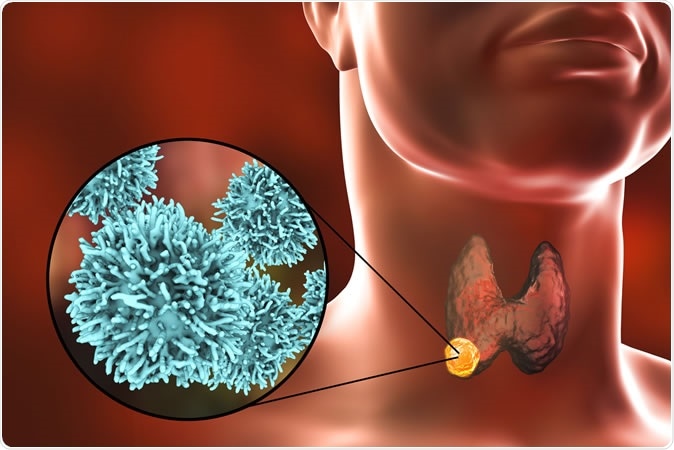In the case of low-risk treated thyroid cancer, some patients may be insisting on unduly intensive surveillance in the form of diagnostic scans to detect recurrence, without clear evidence for any benefit from the same, says a new study published in the Journal of Clinical Oncology.

3D illustration showing thyroid gland with tumor inside human body and closeup view of thyroid cancer cells - Illustration Credit: Kateryna Kon / Shutterstock
Different patients see a need for healthcare differently. Some are “minimizers” who try to defer medical consultations for as long as possible, leaving medical conditions to improve on their own. Others are “maximizers” who insist on the most complete range of treatment for any health issue, whether or not a specific measure actually improves the outcome.
So who decides when patients are actually using up healthcare resources that they don’t really “need”? It’s the patients themselves, in many cases, thanks to strong patient advocacy. Prior studies by these researchers have indicated the role played by physicians in deciding what follow-up should be given for low-risk patients with treated thyroid cancer. The present research was focused on examining patient attitudes towards their care – hence the differentiation of maximizers from minimizers.
The study sample retrieved data from the SEER registries of thyroid cancer patients in Los Angeles and Georgia, maintained by the National Cancer Institute, covering almost 2200 patients from the years 2014 and 2015. All these patients had thyroid cancer during the study period but were currently healthy after having received effective treatment. The researchers studied the attitudes of these patients to the care they had sought over the last year, as well as the actual care they had received. This was the basis for the threefold classification into minimizers (32%), moderate maximizers (43%) and strong maximizers.
Strong maximizers
This category contained over a quarter of all patients (26%) in the whole group. These patients were much more likely (39%) to have visited the doctor at least four times over the last year, compared to 25% to 27% for the other two groups. About 30% of strong maximizers had two or more neck ultrasounds in the last year compared to 18% and 25% for minimizers and moderate maximizers respectively.
The findings were tested for validity after adjusting for age, sex, stage of cancer at the time of diagnosis, and the presence of other health conditions. Even then, the chances of the following events were increased for strong maximizers compared to minimizers:
- 4 or more physician visits – 45% more likely
- 2 or more neck ultrasounds – 58% more likely
- 1 or more radioisotope scans – 73% increased likelihood
- 1 or more additional imaging study – more than double the likelihood
Researcher Megan Haymart says, “These results help to explain why we see significant differences in the management of low-risk thyroid cancer that isn't explained by disease-related factors.” In other words, maximizers used up a lot of physician time, imaging resources and follow-up care whether or not their stage of disease warranted it, compared to other patient categories.
Implications
The objective of the study is summed up by Haymart: “We believe that thyroid cancer can serve as a model for the impact of patient attitudes on medical resource use following surgery in other low-risk cancers.” The same reasons may explain why some groups of patients seek a level of follow-up care that is not really reflected in the ultimate outcomes, such as for indolent prostate cancer and slow-growing breast cancers. In these cases, the patient is far more likely to die of old age or another medical condition than from the cancer itself, which doesn’t, in most cases, interfere with the quality of life.
Thus doctors may find the study results useful in identifying the extent to which patients are dictating the use of resources, pushing up the costs of care unnecessarily as well as exposing themselves to useless health risks, for instance, from radioactive exposures. This recognition can help them ponder on the actual lack of relationship between strict follow-up and an improved outcome in some conditions, and communicate this to the patient. It could also help them analyze to what extent patient attitudes to care should help decide on the actual shape the surveillance should take in each case.
As another researcher, Joshua Evron, says, “There's a tendency to think of cancer as this big bad thing that we just need to throw everything we have in our arsenal at. But that's not necessarily the case. Doctors may be able to better help patients understand the potential benefits of a less intensive approach.”
Journal reference:
Role of patient maximizing-minimizing preferences in thyroid cancer surveillance. Joshua M. Evron, David Reyes-Gastelum, Mousumi Banerjee, Laura D. Scherer, Lauren P. Wallner, Ann S. Hamilton, Kevin C. Ward, Sarah T. Hawley, Brian J. Zikmund-Fisher, and Megan R. Haymart. Journal of Clinical Oncology. https://doi.org/10.1200/JCO.19.01411. https://ascopubs.org/doi/full/10.1200/JCO.19.01411